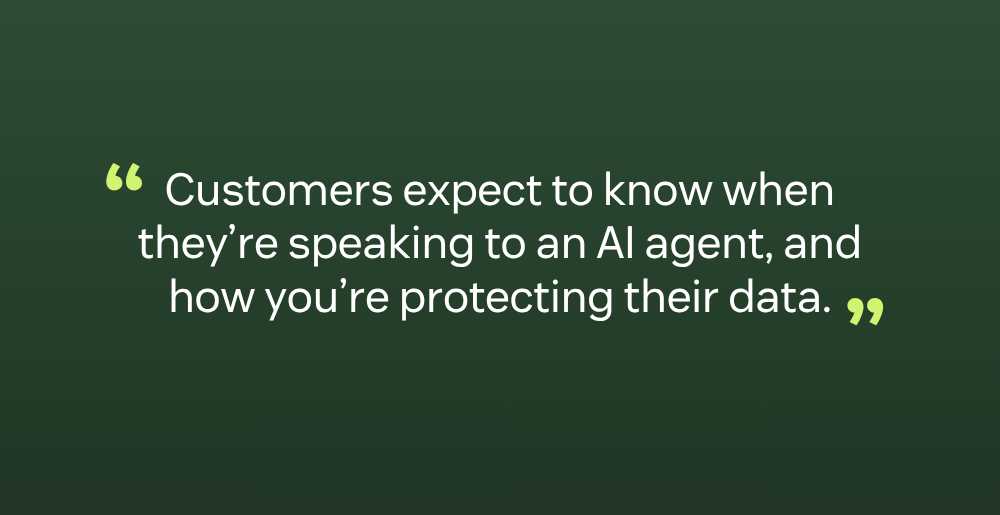Article • 5 min read
Everyone’s launching AI agents. Few are ready for them.
Behind every successful AI agent is a smarter support operation. Here are the six foundations for deploying AI agents that actually work.
Maggie Mazzetti
Group Manager, Content Marketing
최종 업데이트: July 25, 2025
Just a few years ago AI agents might have felt like something out of a science fiction novel. Fast forward to today and they’re everywhere—fueling a modern day gold rush for faster answers, lower costs, and always-on scalability.
Teams are under immense pressure to move quickly. Why? Gartner predicts that by 2029, agentic AI will autonomously resolve 80 percent of customer issues and drop operational costs by as much as 30 percent.
Zendesk’s Resolution Platform is built to help CX leaders prepare exactly for this shift. Just look at Degreed—with the right combination of AI agents, automation, and customer insights, they’ve already realized $1M in efficiency gains and seen a 16 percent increase in customer satisfaction.

As with any high-reward opportunity, the stakes are high. Customers today expect fast, seamless service and they’re quick to walk away if they don’t get it. In our most recent customer survey, 63% said companies have only one chance to get it right before they’re off to a competitor. That’s the highest rate we’ve seen in seven years. And while companies are racing to deploy AI agents, few are taking the time to address the critical operational foundations needed for long-term success.
Without clear scope or reliable knowledge sources, your AI agent could end up delivering a frustrating experience full of dead ends. At best, that dings your CSAT. At worst, it drives customers away for good.
Why organizations must prepare for AI agents before they deploy them
AI can be powerful, but it doesn’t guarantee a great experience. Choose the wrong use cases or fail to integrate it into your existing systems, and it can quickly become more of a headache than a help.
Organizations need to move quickly to keep up with the pace of AI-powered change—but they can’t let urgency override readiness. Without the right knowledge, scope, and system integration, even a capable AI agent can struggle to meet customer expectations.

What this means for service leaders: 6 foundations for AI agent success
AI agents only succeed when they’re built on a strong operational foundation. That includes the data, design, governance, and human support systems you put in place.
Here’s what CX leaders should prioritize before deployment—and long after launch:
1. Audit your knowledge and data readiness:
An AI agent can’t answer questions it doesn’t understand. Start by identifying your most common inquiries, then create clear, answerable content and keep it up to date.
Formatting matters: place key facts in the first 75 words, and use conversational language to help the AI retrieve and deliver responses clearly.
Learn more about how the team at Unity continually updates their FAQs to ensure their AI Agent performs at its best.
2. Integrate AI into existing workflows:
AI agents don’t work in a vacuum. They need to be fully integrated into your CX operation and connected to backend systems like your CRM, order database, or help desk platform. This allows them to do more than just answer questions about order status—they can create tickets, pull real-time data, or escalate issues when needed.
3. Define the AI agent’s scope and build escape hatches:
Rather than trying to automate everything, everywhere, all at once, start by clearly defining what your AI agent is (and isn’t) responsible for.
Simple, repetitive questions like password resets or order tracking are ideal for automation. Give your AI agent clear boundaries and define when to bring in a human—especially for highly regulated, emotional, or high-risk interactions. With the right design and safeguards, even complex issues can be automated confidently. Lastly, don’t forget escape hatches: make it easy for customers to reach a human at any time.
4. Prioritize human oversight and training:
Even the most advanced AI agent needs a human in the loop. Assign a dedicated AI operations team to review interactions, and refine performance.
At the same time, train your teams to work with AI, not around it. Right now, there’s a significant gap—only 45% of agents we surveyed reported getting any AI training.
5. Establish governance and measure what matters:
Good AI requires good strategy. Before deployment, ask: What does success look like? What KPIs are we tracking (including new ones like containment or fallback rate)? How often should the AI agent handle sensitive data? What should it do when it doesn’t have an answer?

Establishing a strong governance framework in close partnership with IT and data teams will ensure quality, transparency, and compliance. Customers expect to know when they’re speaking to an AI agent, and how you’re protecting their data. Meeting those expectations builds trust.
6. Design with your customer in mind:
Design your AI agent with your customers in mind. Should it have a name? What tone should it use—professional, playful, friendly?
Make sure it introduces itself clearly and sets expectations. The best experiences feel human, even when they’re not. Keep responses empathetic and focused, use rich media (images, videos, quick-reply buttons, etc) when helpful, and always offer a path to a human.
Treat AI as a program, not a project
Just as you wouldn’t build a house without a strong foundation, you shouldn’t deploy AI agents without the core elements they need to deliver consistent, high-quality experiences.
Companies that are leading—and seeing powerful results from their AI agents—have one thing in common: they’re building for the long term. They approach AI not as a one-time launch, but an ongoing commitment.
By regularly auditing their knowledge bases, closing content gaps, refining outputs, and scaling with intention, they’re laying the groundwork for AI agents that grow more capable, more aligned, and more trusted with every interaction.
